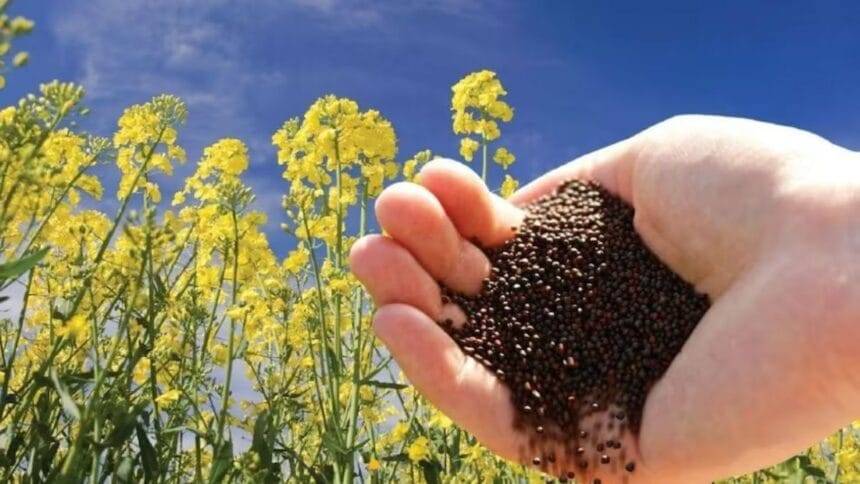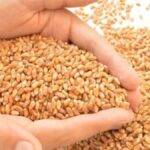Main Points In Hindi (मुख्य बातें – हिंदी में)
नीचे कुछ मुख्य बिंदु दिए गए हैं जो सरसों के उन्नत विविधताओं के बारे में जानकारी प्रदान करते हैं:
-
सरसों की महत्वता और उत्पादन: सरसों मुख्यतः रबी मौसम की प्रमुख तेल बीज फसल है, जिसे बरसाती क्षेत्रों में सिंचाई या संरक्षित नमी में उगाया जाता है। राजस्थान इस फसल के उत्पादन में एक प्रमुख स्थान रखता है और यहाँ के पश्चिमी क्षेत्र में राज्य की कुल सरसों उत्पादन का 29 प्रतिशत होता है।
-
उन्नत विविधताओं का उपयोग: वैज्ञानिकों का मानना है कि उन्नत तकनीक और उच्च गुणवत्ता वाली किस्में उपयोग करने से सरसों की उपज में 30 से 60 प्रतिशत की वृद्धि की जा सकती है। जैसे ‘लक्ष्मी’ (RH 8812) एक उन्नत किस्म है जो 135-140 दिन में पककर तैयार होती है और इसकी औसत उपज 20-22 क्विंटल प्रति हेक्टेयर होती है।
-
लक्ष्मी किस्म की विशेषताएँ: लक्ष्मी किस्म की विशेषता है कि इसके फली पकने पर नहीं फटतीं, जिससे फसल के दौरान अनाज की गिरावट कम होती है। अन्य किस्मों की तुलना में इसके बीज मोटे और काले होते हैं।
-
अन्य उन्नत किस्में: अन्य उन्नत सरसों की किस्में जैसे ‘पुसा जय किसान’, ‘आशीर्वाद’, ‘RH 30’, ‘पुसा BLD’ और ‘क्रांति (PR 15)’ भी हैं, जो विभिन्न विशेषताओं और उपज क्षमता के साथ आती हैं। ये किस्में विभिन्न प्रकार के जलवायु और रोगों के प्रति प्रतिरोधी होती हैं।
- उर्वरक और खेत की तैयारी: सरसों की फसल के लिए खेत में 8-10 टन सड़ी हुई गोबर की खाद या कंपोस्ट को मिट्टी में मिलाने और मिट्टी परीक्षण के अनुसार उर्वरक देने की सलाह दी गई है। सिंचाई वाले क्षेत्रों में 60 किग्रा नाइट्रोजन और 40 किग्रा फास्फोरस का प्रयोग आवश्यक है, साथ ही गैर-सिंचाई वाले क्षेत्रों के लिए भी उचित मात्रा में उर्वरक लगाना चाहिए।
इन बिंदुओं से सरसों की खेती और बेहतर उपज के लिए आवश्यक उपायों का ज्ञान मिलता है।


Main Points In English(मुख्य बातें – अंग्रेज़ी में)
Here are the main points from the text regarding mustard cultivation and improved varieties:
-
Importance of Improved Varieties: Before cultivating mustard, understanding improved varieties is crucial. Advanced technology and these varieties can enhance mustard yield by 30 to 60 percent, with an average yield currently at 700 kg per hectare in Rajasthan.
-
Prominent Varieties: Several improved mustard varieties are highlighted:
- Lakshmi (RH 8812): Ripening in 135-140 days, yields 20-22 quintals per hectare, and features non-cracking pods.
- Pusa Jai Kisan: Ripening in 125-130 days and yields 18-20 quintals, resistant to specific diseases.
- Blessings: Suitable for late sowing with a yield of 16-18 quintals.
- RH 30: Yields 18-20 quintals with thick grains and lower disease incidence.
- Pusa BLD: Yields 18-20 quintals, with thicker grains and reduced disease presence.
- Revolution (PR 15): Non-irrigated suitable variety with a yield of 16-18 quintals.
-
Soil Preparation and Fertilization: Proper preparation involves mixing 8-10 tonnes of compost or rotten cow dung before sowing, followed by guided fertilizers based on soil tests, including nitrogen, phosphorus, and sulfur for optimal growth.
-
Challenges in Cultivation: A major issue in mustard farming is pod cracking, which results in grain loss. The variety Lakshmi specifically addresses this problem by preventing pods from cracking during harvest.
- Regional Significance: Rajasthan is a key area for mustard production in India, contributing to 29 percent of the state’s total output, particularly in the western region.
Complete News In Hindi(पूरी खबर – हिंदी में)
सरसों की खेती करने से पहले, बेहतर किस्मों के बारे में जानना ज़रूरी है। सरसों मुख्य रूप से रबी सत्र में उगाई जाने वाली तेल फसलों में से एक है, और इसे बारिश पर निर्भर क्षेत्रों में बुवाई की जाती है। भारत में सरसों उत्पादन में राजस्थान का एक प्रमुख स्थान है। राज्य के पश्चिमी क्षेत्र में कुल सरसों उत्पादन का 29 प्रतिशत कार्यरत है। एक आईसीएआर रिपोर्ट के अनुसार, इस क्षेत्र में सरसों की औसत उपज (700 किलोग्राम प्रति हेक्टेयर) काफी कम है। कृषि वैज्ञानिकों का कहना है कि उन्नत प्रौद्योगिकी और बेहतर किस्मों का उपयोग करके सरसों की उपज 30 से 60 प्रतिशत बढ़ाई जा सकती है।
इनमें से एक बेहतर किस्म है, लक्ष्मी (RH 8812), जिसका पकने का समय 135-140 दिन है। इसकी औसत उपज 20-22 क्विंटल प्रति हेक्टेयर है। इस किस्म की विशेषता यह है कि इसकी फली कटाई के समय नहीं फटती और दाने मोटे और काले होते हैं। सरसों की खेती में एक बड़ी समस्या फली का फटना है, जिससे खेत में बहुत सारे दाने गिर जाते हैं। इन दानों को इकट्ठा करना कठिन होता है क्योंकि वे बहुत छोटे होते हैं। लक्ष्मी एक ऐसी बेहतर किस्म है, जिसकी फली पकने पर नहीं फटती।
किसान भाइयों, अगर आप सरसों की उपज बढ़ाना चाहते हैं, तो इस खास विधि से खेती करें।
सुधारी गई सरसों की किस्में
पुष्पा जय किसान
इसकी पकने की अवधि 125-130 दिन है। इसकी औसत उपज 18-20 क्विंटल प्रति हेक्टेयर है। यह किस्म सफेद रोली, उकता और तुलसीता रोगों के प्रति प्रतिरोधी है और सहायक जल और गैर-सहायक बारिश वाले क्षेत्रों के लिए उपयुक्त है।
आशीर्वाद
पकने की अवधि 125-130 दिन है। उपज 16 से 18 क्विंटल है। इसे देर से बोया जा सकता है। इसे सिंचित क्षेत्रों के लिए उपयुक्त माना जाता है।
RH 30
इसकी पकने की अवधि 130 से 135 दिन है। उपज 18 से 20 क्विंटल प्रति हेक्टेयर होती है। इसके दाने मोटे होते हैं। मोयला का प्रकोप कम होता है। यह सिंचित और गैर-सिंचित दोनों क्षेत्रों के लिए उपयुक्त है।
पुष्पा बीएलडी
इस किस्म की पकने की अवधि 125-130 दिन है। उपज 18-20 क्विंटल है। इसके दाने मोटे होते हैं और रोग कम होते हैं।
क्रांति (PR 15)
इसकी पकने की अवधि 125-130 दिन है। औसत उपज 16-18 क्विंटल प्रति हेक्टेयर है। यह तुलसीता और सफेद रोली रोग के प्रति प्रतिरोधी है, और इसके दाने मोटे और भाड़े रंग के होते हैं। यह किस्म गैर-सिंचित क्षेत्रों के लिए उपयुक्त है।
किसान भाइयों, सरसों की फसल के लिए सख्त गाय के गोबर या खाद का 8-10 टन उपयोग करना चाहिए और इसे बोने से कम से कम तीन से चार हफ्ते पहले खेत में अच्छी तरह मिलाना चाहिए। इसके बाद, मिट्टी की जांच के आधार पर, सिंचित फसलों के लिए, बोने के समय 60 किलोग्राम नाइट्रोजन और 40 किलोग्राम फास्फोरस को नाली में मिलाना चाहिए, जैसे 87 किलोग्राम डीएपी और 32 किलोग्राम यूरिया या 65 किलोग्राम यूरिया और 250 किलोग्राम सिंगल सुपर फास्फेट। पहले सिंचाई के समय 30 किलोग्राम नाइट्रोजन को 65 किलोग्राम यूरिया के साथ छिड़काव करना चाहिए। इसके अलावा, जब फसल 40 दिन की हो जाती है, तो 40 किलोग्राम सल्फर पाउडर दिया जाना चाहिए। गैर-सिंचित क्षेत्रों में, बोने के समय 40 किलोग्राम नाइट्रोजन और 40 किलोग्राम फास्फोरस 87 किलोग्राम डीएपी और 54 किलोग्राम यूरिया प्रति हेक्टेयर दिया जाना चाहिए।
Complete News In English(पूरी खबर – अंग्रेज़ी में)


Before cultivating mustard, it is important to know about improved varieties. Mustard is the main oilseed crop grown in Rabi season which is cultivated in rainfed areas in irrigated and conserved moisture. Rajasthan has a prominent place in mustard production in the country. The western region produces 29 percent of the total mustard production of the state. An ICAR report shows that the average yield of mustard (700 kg per hectare) in this area is quite low. Agricultural scientists say that by using advanced technology and sowing improved varieties, the yield of mustard can be increased by 30 to 60 percent.
Among these, there is an improved variety of mustard, Lakshmi (RH 8812) whose ripening period is 135-140 days. Its average yield is 20-22 quintals per hectare. This variety has many specialties in which the special one is that its pods do not crack when harvested and the grains are thick and black. A major problem in mustard cultivation is the cracking of pods and due to this a large quantity of grains fall in the field. It is difficult to pick up these grains because the grains are very small. Lakshmi is such an improved variety whose pods do not crackle when ripe.
Also read: Attention farmers of Chhattisgarh! If you want to increase the yield of mustard then do farming with this special method.
Improved Mustard Varieties
Pusa Jai Kisan
Its ripening period is 125-130 days. Its average yield is 18-20 quintals per hectare. This variety is resistant to Safed Roli, Ukhta and Tulasita diseases, suitable for irrigated and non-irrigated rainfed areas.
Blessings
The ripening period is 125-130 days. The yield is 16 to 18 quintals. It can be sown late. Suitable for irrigated areas.
RH 30
Ripens in 130 to 135 days. The yield is 18 to 20 quintals per hectare. Its grains are thick. The incidence of Moyla is less. Suitable for irrigated and non-irrigated areas.
pusa bld
The ripening period of this variety is 125-130 days. The yield is 18-20 quintals. The grains are thicker and diseases are less common.
Revolution (PR 15)
The ripening period of this variety is 125-130 days. Its average yield is 16 to 18 quintals per hectare. Tulasita and white Roli Rodhika, the grains are thick and brown in colour. This variety is suitable for non-irrigated areas.
Also read: How much DAP and urea should be given in mustard? If you want more oil then add this fertilizer
For mustard crop, 8-10 tonnes of rotten cow dung or compost should be mixed thoroughly in the field at least three to four weeks before sowing. After this, according to the soil test, for irrigated crops, full quantity of 60 kg nitrogen and 40 kg phosphorus should be given in the furrows at the time of sowing, 87 kg DAP and 32 kg urea or 65 kg urea and 250 kg single super phosphate. The remaining 30 kg quantity of nitrogen should be sprayed along with 65 kg urea per hectare at the time of first irrigation. Apart from this, sulfur powder should be given at the rate of 40 kg per hectare when the crop is 40 days old. In non-irrigated areas, 40 kg nitrogen and 40 kg phosphorus should be given at the rate of 87 kg DAP and 54 kg urea per hectare at the time of sowing.








